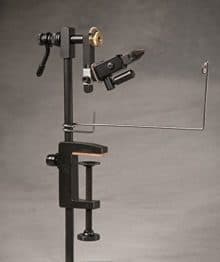Why Is The Wolff Apex Vise One Of Our Favorites?
When the true rotary vise was introduced some four decades ago, it invaded the fly-tying world and held its market since then. Today, every single angler who wishes to learn fly tying goes out seeking for the true rotary tool. However, a conventional rotary vise, such as the Wolff vise, has some characteristics that endear them to old-timers.
One favorite feature is the way you can turn the vise head at an upward angle. This frees up more space between the hook and the base, and also brings the hook nearer to the user. These are just some of the reasons why many fly tying aficionados still prefer the traditional rotary version over the true or inline rotary vise.
The Apex exhibits these mentioned advantages. It also has fewer joined or hinged parts so it’s more solid than most inline rotary models, which either have a bent or joined rotary shaft.
The Wolff Vise, at a Glance
| Vise style | Conventional rotary |
| Material | Stainless steel, hardened steel |
| Base style | Pedestal and C-clamp |
| Hook capacity range | 32 to 7/0 |
| Has a bobbin cradle | No |
| Has a warranty | Yes |
| Price range | Check Price |
Features of the Apex fly tying vise
- This conventional rotary vise affords you a 360-degree view of the hook you’re working on.
- Its main body is constructed of stainless steel, while its jaws are made of hardened tool steel.
- The jaws have grooves for handling hooks from sizes 32 to 7/0.
- You can adjust the vise head to tilt in countless ways.
- It includes both a pedestal and a C-clamp.
Pros:
- With dual base attachments—pedestal and C-clamp—you get a highly-usable vise. It’s the vise that you install on your workbench and the same one you take with you on your fishing trips.
- It has a compact and simple design. With its small footprint, it does not crowd your table. This is a nice feature especially if you have a small workspace. There’s nothing fancy about it—it grips the hook, and you rotate it to view all sides and tie your materials on the hook. It’s this simplicity that makes this vise a classic.
- Its hook size capacity is unbelievable. It can hold the smallest hooks (#32) as well as the largest ones (#7/0) without the slightest slippage. Very few fly tying vises can handle this range without replacing the jaws with midge or saltwater jaw accessories.
- It’s easy to operate and maintain. You won’t need to do too many adjustments just to make it work.
- It comes with a material clip. Most vises don’t include this inconspicuous yet important accessory.
- It’s relatively inexpensive. With the same build and function, you’d expect a vise to cost more.
- It has a lifetime warranty from the manufacturer.
- It is made in the USA.
Cons:
- The stem is kind of short. You’re left with adjusting the angle upward to attain more clearance than what it offers.
- The pedestal is quite small. However, if your purpose is to have a travel vise, then this compact size should work well for you.
- It doesn’t come with a bobbin cradle. Some people don’t find the need for a bobbin cradle. If you’re like that, then this lack shouldn’t be an issue. On the other hand, if you’re the type who keeps messing his or her threads when not using a bobbin cradle, then you better buy one. We suggest that you purchase one similar to the bobbin cradle that comes with the Peak vise, which is easy to swing in or out of the way.
- The locking mechanism for tightening the rotary shaft does not feel as smooth or refined as when you’re tightening a Peak vise. If there’s anything to be improved on the Apex vise, it’s the fine-tuning of its locking screws.
Conclusion
If and when you decide to buy a fly tying vise, you’d have to set your expectations right. It’s a conventional rotary vise. That means that it operates differently from a true-rotary type.
Like a true-rotary vise, it will hold and fully rotate a hook and allow viewing of all sides. Unlike a true-rotary vise, its manner of rotating the hook is different. In the true rotary setup, the rotary shaft and hook shank rotate around the same horizontal axis. In the conventional setup, the hook has its own axis of rotation, which is not “inline” with that of the rotary shaft.
Thus, you will observe a deviation of the hook shank from the rotary shaft’s centerline. This is the only difference between this vise and a true rotary vise. The question is: Are you willing to pay more for this difference? If you would rather spend on durability and ease of use, then you won’t regret buying this fly vise. It’s one of the most intelligent choices out there, and it comes from a trusted company.




